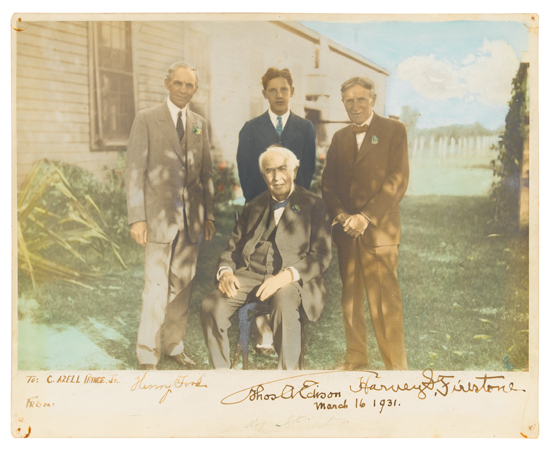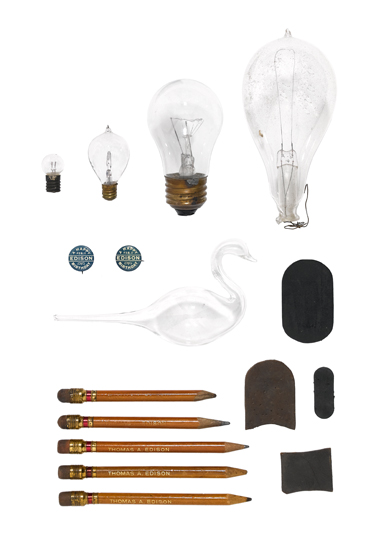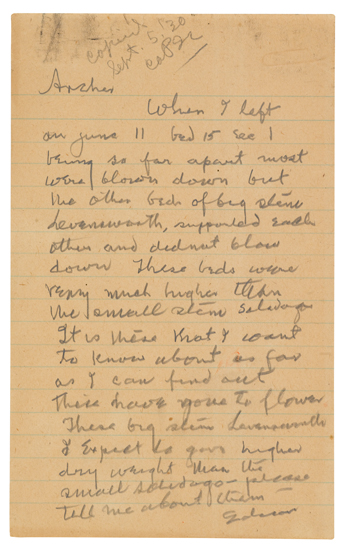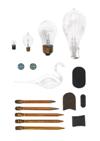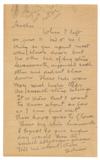Sale 2174 - Lot 131
Unsold
Estimate: $ 50,000 - $ 75,000
ONE OF EDISON'S LAST EXPERIMENTS: RUBBER FROM GOLDENROD (EDISON, THOMAS.) Archive of Edison's notes and correspondence kept by his last assistant, C.A. Prince Jr. Thousands of pages in 3 boxes, 1.2 linear feet, including more than 130 sheets in Edison's hand, plus 20 artifacts; various sizes and conditions, many of the Edison notes are on fairly brittle notepad paper, and a few have separations at the folds. Vp, ca 1900-2005, most 1930-34
Additional Details
Claude Azell Prince Jr. (1913-2005) grew up in Fort Myers, FL, the winter home of Thomas Edison. His father worked as a chemist for Edison. Upon graduating from high school in 1930, the son was hired by Edison as assistant secretary and record keeper, following the inventor between his New Jersey lab and his Florida winter quarters. Though Edison was 80 years old, he remained very active. One of his last projects was an effort to extract rubber from goldenrod plants, a project in which both Princes were closely involved until Edison''s death in October 1931. They continued working on with Edison Laboratories until 1934. C.A. Prince Jr. was the last known surviving employee of Thomas Edison.
The most important part of this archive is a group of correspondence and laboratory notes in Edison''s hand, most of them relating to the goldenrod experiments. Edison would jot down observations or orders, and then give them to young Prince for transcription and filing. These notes include 31 draft Autograph Letters Signed by Edison (signed variously as TAE, Edison, or simply "E"), 6 incomplete letters in Edison''s hand, 82 sheets of lab notes in Edison''s hand, and at least 6 other sheets annotated by Edison.
Most of Edison''s letters are addressed either to his brother-in-law John V. Miller in the New Jersey office, or to Walter N. Archer who was supervising the goldenrod plantation. The 15 letters written to Archer are particularly full of scientific detail, and also express Edison''s impatience: "Archer--Every letter you send explaining matters makes it worse. We have puzzled for hours but cannot make head or tail to it. 1st. If you plant bed 9 inches apart & let them grown until ripe, will there be any pups come up" (30 September 1930). A bit of Edison''s general correspondence is also found in the collection, such as this draft telegram to the editor of the London Daily Express: "I feel sure scientific advancement will make this world a better place for us all, because it leads to correct thinking verifiable by experiment. Edison" (10 February 1931). In response to a telegram asking him to sponsor a prohibition campaign, Edison writes: "Will be one of sponsors but cannot perform any duties on account of poor health and rubber experiments. Thos. A. Edison."
The collection also includes 75 related period photographs, most of them snapshots depicting Edison or his laboratories. Henry Ford, a Florida neighbor, appears in at least four photographs. Most notable are three photographs which Edison signed for Prince. One of them depicts Edison with Henry Ford, Roger Firestone, and Harvey Firestone in 1931, and is signed by all four. Prince claimed to be faintly visible in the window behind the group. Other photographs show Edison with Prince, and another shows Prince carrying a tray of spinach to Edison''s office.
Among the 20 artifacts in the collection are a light bulb claimed to have been used on Edison''s yacht Mina in 1901 (with early provenance note) Three other early light bulbs A glass swan created by Edison''s glassblower as a prank (slightly broken at tip) 2 spoons from the lab, one of them engraved "Edison" 5 thick Eagle pencils embossed "Thomas A. Edison," which had been specially ordered for Edison''s use because he found them easier to write with A pestle 4 small rubber samples, presumably from the goldenrod experiments.
Notes and reports on the goldenrod experiment by other members of Edison''s project team are dated 1931-34, and run to more than 300 pages, explaining the broader context of the experiment. Rounding out the collection are 30 folders of articles, notes, and memorabilia relating to Edison, compiled by C.A. Prince through 2005, including Prince''s own personal reminiscences. A more detailed inventory of this important scientific archive is available upon request.
The most important part of this archive is a group of correspondence and laboratory notes in Edison''s hand, most of them relating to the goldenrod experiments. Edison would jot down observations or orders, and then give them to young Prince for transcription and filing. These notes include 31 draft Autograph Letters Signed by Edison (signed variously as TAE, Edison, or simply "E"), 6 incomplete letters in Edison''s hand, 82 sheets of lab notes in Edison''s hand, and at least 6 other sheets annotated by Edison.
Most of Edison''s letters are addressed either to his brother-in-law John V. Miller in the New Jersey office, or to Walter N. Archer who was supervising the goldenrod plantation. The 15 letters written to Archer are particularly full of scientific detail, and also express Edison''s impatience: "Archer--Every letter you send explaining matters makes it worse. We have puzzled for hours but cannot make head or tail to it. 1st. If you plant bed 9 inches apart & let them grown until ripe, will there be any pups come up" (30 September 1930). A bit of Edison''s general correspondence is also found in the collection, such as this draft telegram to the editor of the London Daily Express: "I feel sure scientific advancement will make this world a better place for us all, because it leads to correct thinking verifiable by experiment. Edison" (10 February 1931). In response to a telegram asking him to sponsor a prohibition campaign, Edison writes: "Will be one of sponsors but cannot perform any duties on account of poor health and rubber experiments. Thos. A. Edison."
The collection also includes 75 related period photographs, most of them snapshots depicting Edison or his laboratories. Henry Ford, a Florida neighbor, appears in at least four photographs. Most notable are three photographs which Edison signed for Prince. One of them depicts Edison with Henry Ford, Roger Firestone, and Harvey Firestone in 1931, and is signed by all four. Prince claimed to be faintly visible in the window behind the group. Other photographs show Edison with Prince, and another shows Prince carrying a tray of spinach to Edison''s office.
Among the 20 artifacts in the collection are a light bulb claimed to have been used on Edison''s yacht Mina in 1901 (with early provenance note) Three other early light bulbs A glass swan created by Edison''s glassblower as a prank (slightly broken at tip) 2 spoons from the lab, one of them engraved "Edison" 5 thick Eagle pencils embossed "Thomas A. Edison," which had been specially ordered for Edison''s use because he found them easier to write with A pestle 4 small rubber samples, presumably from the goldenrod experiments.
Notes and reports on the goldenrod experiment by other members of Edison''s project team are dated 1931-34, and run to more than 300 pages, explaining the broader context of the experiment. Rounding out the collection are 30 folders of articles, notes, and memorabilia relating to Edison, compiled by C.A. Prince through 2005, including Prince''s own personal reminiscences. A more detailed inventory of this important scientific archive is available upon request.
Exhibition Hours
Exhibition Hours
Aliquam vulputate ornare congue. Vestibulum maximus, libero in placerat faucibus, risus nisl molestie massa, ut maximus metus lectus vel lorem.



